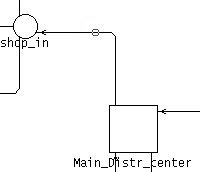

Course description: (English - Hungarian)
Course on Business modelling, supported by
automated tools, by dr. R.J.C. Kusters, dr. Marc Voorhoeve,
dr. Lou Somers and Ron Vodegel, Eindhoven University of Technology,
22 January - 3 February 1996
Original documentetion:
WinWord format exspect.doc
RTF format exspect.rtf
Source code:
Main idea:
We have to simulate a shopping network. The system based on a
distribution center with three shops each with one customer and
a supplier connected to the distribution center. We have to build
up a monitoring system to check the average level of the stocks.
The top model:
Description of the basic element:
Customer:
Every customer has the same behavior. They send one order in every
2 seconds to the shops with random selection from the available
goods. The customer accepts all the arriving articles. As only
one customer connected to each shop in my system special identifier
not needed.
Shop:
In my network I build up three shops. Every shop has a unique
ID to make difference between the orders sent to the distribution
center. In the model every shop has two independent stores. First
is the real store with the amount of goods available. Second is
the virtual store with the ordered stock level. At the beginning
the starting stock levels in the two stores are the same. The
shop accepts every order. If there is not enough article in the
real store the order has to wait for the service. If the stock
level is too low in the virtual stock the shop sends an order
to the distribution center. If the stock is available the warehouse
delivers immediately, if not it is necessary to wait for the delivering
from the supplier.
Distribution center:
The distribution center and the shops have manly the same functionality.
While the supplier delays with the delivery some time 7 days the
distribution center has higher stock level then the shops.
Supplier:
The supplier receives orders from the warehouse, and satisfies
it with a random delay between 2 and 7 days. The delay's distribution
over this interval is uniform.
Monitoring system:
The monitoring system collects information from the shops and
the distribution center. Every time when the real stock has changed
the monitoring system receives the old stock levels from the shops
and the distribution center. The monitoring system calculates
the average stock level at every change.
Simulation results after four weeks:
Shop 1
| avg: real: 50.1167 | prodid: str: bike |
| avg: real: 52.2719 | prodid: str: radio |
| avg: real: 53.3104 | prodid: str: tv |
| avg: real: 54.2570 | prodid: str: moto |
Shop 2
| avg: real: 48.7071 | prodid: str: tv |
| avg: real: 52.2374 | prodid: str: radio |
| avg: real: 53.4782 | prodid: str: bike |
| avg: real: 53.8712 | prodid: str: moto |
Shop 3
| avg: real: 47.8609 | prodid: str: moto |
| avg: real: 49.7075 | prodid: str: radio |
| avg: real: 50.6471 | prodid: str: tv |
| avg: real: 53.3478 | prodid: str: bike |
Distribution center
| avg: real: 83.2323 | prodid: str: moto |
| avg: real: 84.9410 | prodid: str: tv |
| avg: real: 87.3464 | prodid: str: radio |
| avg: real: 97.7654 | prodid: str: bike |
Last modified: March 12, 1996, fmarton@inf.bme.hu
marton@dutiba.twi.tudelft.nl
marton@and.nl